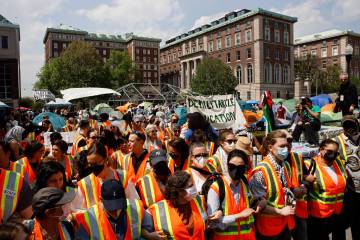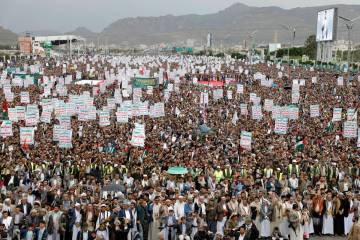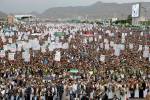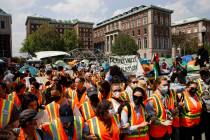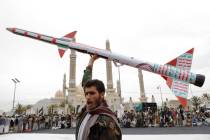Northern Arizona watches winds during wildfires
FLAGSTAFF, Ariz. — The northern Arizona city of Flagstaff is synonymous with mountains — lush with ponderosa pines, meadows and hiking trails that are a respite from the desert heat farther south.
Now, parts of them are burning yet again, fanned by winds that pushed one fire through more than 27 square miles. Winds moderated Tuesday after a day of red flag conditions, which could help firefighters get a better handle on a blaze that has largely spared homes but made a run into a wilderness area and reached a lava dome volcano.
“They’re optimistic to make some headway,” fire information officer Cathie Pauls said Tuesday.
Residents around the city looked toward the mountains as smoke billowed through the air and winds howled early this week, some scared, some nervous — most hoping that moisture in the forecast late this week brings some relief.
“We’re most definitely dry,” said Flagstaff resident Colin Challifour. “The forests are dry. It’s unfortunate. You don’t like to see it.”
Authorities downgraded evacuation orders Tuesday but people in about 700 homes still were under orders to stay out of the area, the Coconino County Sheriff’s Office said. Another 280 homes have been evacuated because of another wildfire that’s burned 4 square miles on the outskirts of Flagstaff in a more remote area.
One home and a secondary structure have been destroyed in the larger fire, the sheriff’s office said. Wildfires have also forced evacuations in California and New Mexico.
In northern Arizona, Coconino County declared an emergency because of the wildfire.
Fire incident commander Aaron Graeser said the big Flagstaff-area blaze is one of the top priorities in the country for firefighting resources.
Western fires
Wildfires broke out early this spring in multiple states in the Western U.S., where climate change and an enduring drought are fanning the frequency and intensity of forest and grassland fires. A springtime fire outside Flagstaff destroyed more than two dozen homes. Most of the residents who evacuated then are out of their homes again because of this latest wildfire.
The number of square miles burned so far this year is more than double the 10-year national average, and states like New Mexico have already set records with devastating blazes that destroyed hundreds of homes while causing environmental damage that is expected to affect water supplies.
Nationally, more than 6,200 wildland firefighters were battling nearly three dozen uncontained fires that had charred over 1,780 square miles — much of it in the U.S. Southwest, according to the National Interagency Fire Center.
In southwest Alaska, favorable winds shifted the progression of a large fire burning through dry grass and brush in largely treeless tundra away from an Alaska Native village, fire managers said Tuesday.
The 202-square-mile East Fork Fire remained just over 3 miles from St. Mary’s, but there were no evacuation orders in place. No structures have been damaged or lost.
The wind shift along with cooler temperatures allowed firefighters to work the active western edge of the East Fork fire and shore up primary and secondary contain lines protecting St. Mary’s and the nearby villages of Pitkas Point, Mountain Village and Pilot Station.
California
Favorable weather conditions may last longer than expected, possibly into next week, a statement from Alaska Wildland Fire Information said. The fire was started by lightning May 31.
In California, firefighters reported significant progress against a wildfire near the San Gabriel Mountains community of Wrightwood, but evacuation orders and warnings remained in place. The blaze has scorched about 1.5 square miles since erupting during the weekend and was 27% contained.
In Northern California’s Tehama County, firefighters gained 30% containment of a fire that has destroyed 10 buildings, damaged four others and threatened about 160 structures, fire officials said.
In a wildfire-related situation, a 50-mile stretch of State Route 70 in Northern California remained closed indefinitely after mud, boulders and dead trees inundated lanes during flash floods along a burn scar.
The causes of the latest California fires were under investigation.
Lightning is suspected in one of the northern Arizona fires, but authorities don’t yet know what caused the larger wildfire.
Parts of U.S. Route 89, the main route to reach the Grand Canyon’s East Rim entrance and through the Navajo Nation and up into Utah, remained closed, as did the Arizona Snowbowl ski resort.




